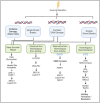Understanding and Exacerbating the Biological Response of Uveal Melanoma to Proton Beam Therapy
- PMID: 41097633
- PMCID: PMC12523287
- DOI: 10.3390/cancers17193104
Understanding and Exacerbating the Biological Response of Uveal Melanoma to Proton Beam Therapy
Abstract
Uveal melanoma (UM) is the most common primary intraocular malignancy in adults, associated with a high tendency for metastasis to the liver. Proton beam therapy (PBT) is the preferred external radiotherapy treatment for primary UM of certain sizes and locations in the eye, due to its efficacy and good local tumour control, as well as its precision to spare surrounding ocular structures. PBT is an effective alternative to surgical enucleation and other non-precision-targeted radiotherapies. Despite this, the radiobiology of UM in response to PBT is still not fully understood. This enhanced knowledge would help to further optimise UM treatment and improve patient outcomes through reducing radiation dosage to ocular structures, treating larger tumours that would otherwise require enucleation, or even offering a treatment strategy for the otherwise fatal liver metastases. In this review, we explore current knowledge of the treatment of UM with PBT, evaluating the biological responses to the therapy. Molecular factors, such as tumour size, oxygen tension levels, DNA damage proficiency, and autophagy, are known to influence the cellular response to radiotherapy, and these will be discussed. Furthermore, we examine innovative strategies to enhance radiotherapy outcomes, such as combination therapies with DNA damage repair and autophagy modulators, as well as advancements in PBT planning and delivery. By integrating current research and emerging technologies, we aim to provide opportunities to improve the therapeutic effectiveness of PBT in UM management.
Keywords: DNA damage; DNA repair; autophagy; hypoxia; ionising radiation; proton beam therapy; uveal melanoma.
Conflict of interest statement
The authors declare no conflicts of interest.
Figures




References
-
- Khoja L., Atenafu E.G., Suciu S., Leyvraz S., Sato T., Marshall E., Keilholz U., Zimmer L., Patel S.P., Piperno-Neumann S., et al. Meta-analysis in metastatic uveal melanoma to determine progression free and overall survival benchmarks: An international rare cancers initiative (IRCI) ocular melanoma study. Ann. Oncol. 2019;30:1370–1380. doi: 10.1093/annonc/mdz176. - DOI - PubMed
-
- Olofsson Bagge R., Nelson A., Shafazand A., Cahlin C., Carneiro A., Helgadottir H., Levin M., Rizell M., Ullenhag G., Wirén S., et al. A phase Ib randomized multicenter trial of isolated hepatic perfusion in combination with ipilimumab and nivolumab for uveal melanoma metastases (SCANDIUM II trial) ESMO Open. 2024;9:103623. doi: 10.1016/j.esmoop.2024.103623. - DOI - PMC - PubMed
Publication types
Grants and funding
LinkOut - more resources
Full Text Sources

